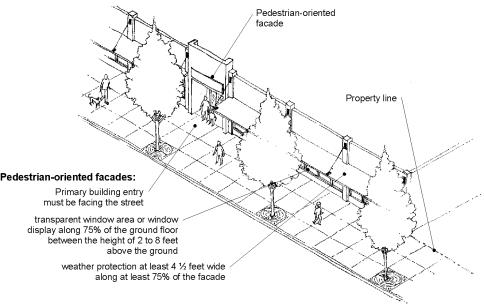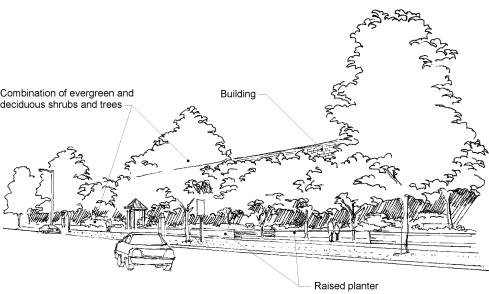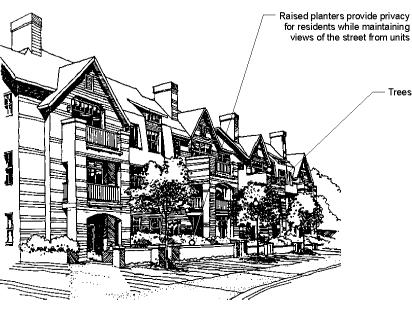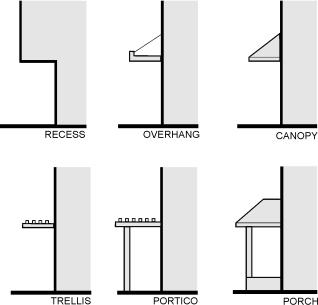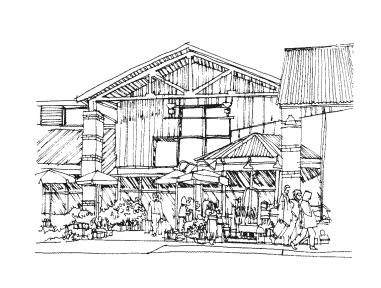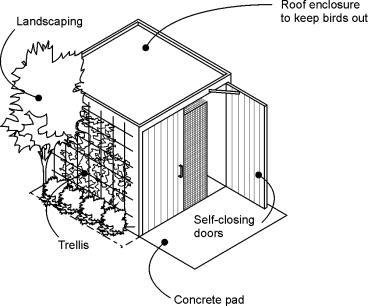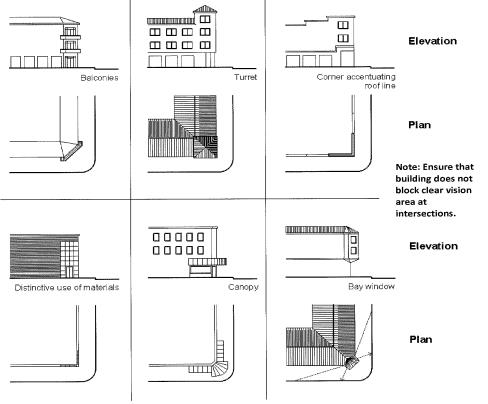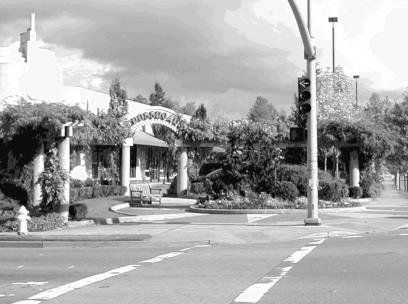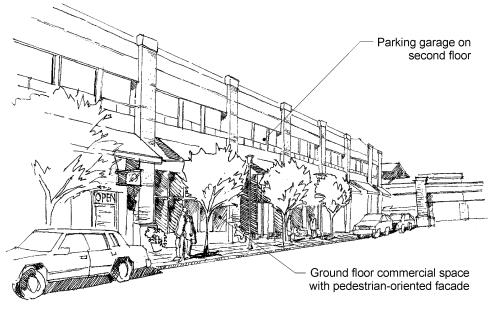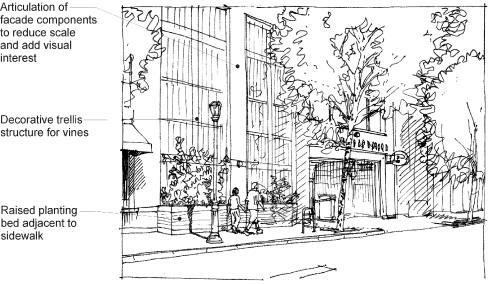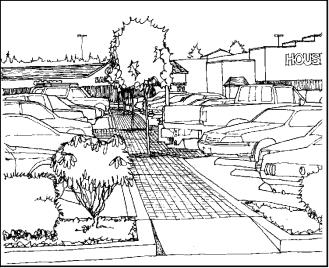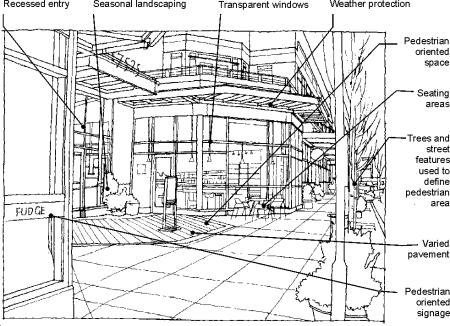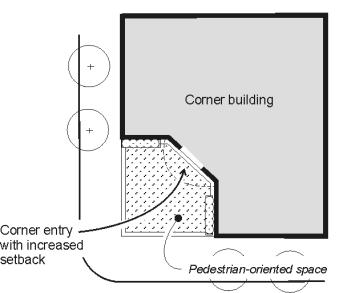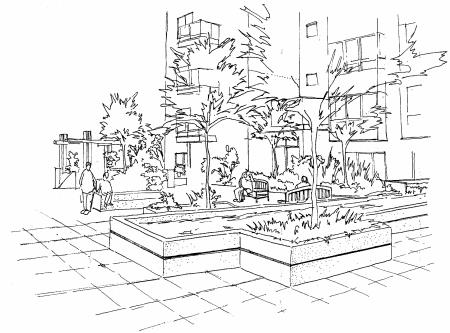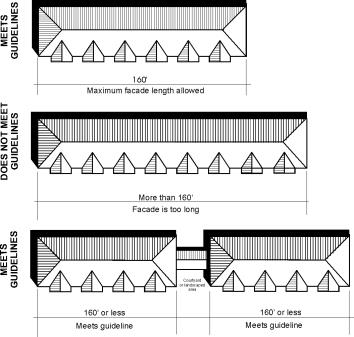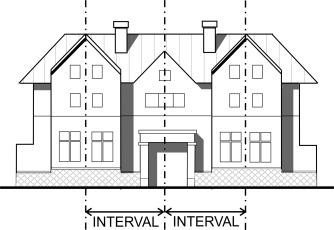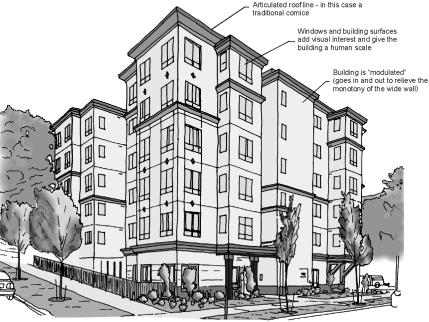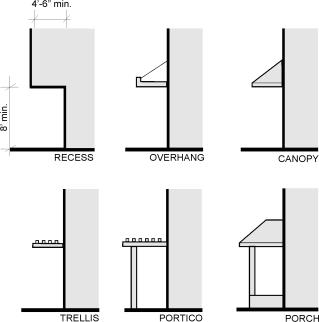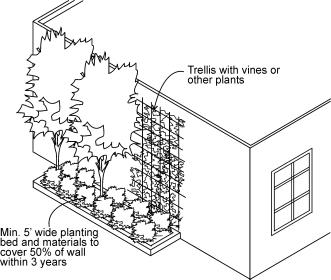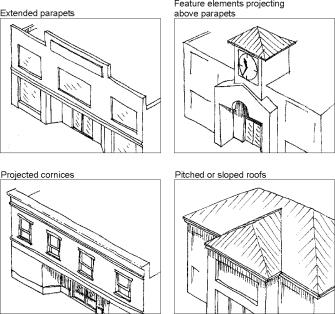4-3-100 URBAN DESIGN REGULATIONS:
A. PURPOSE:
1. These urban design regulations are established in accordance with and to implement policies established in the Land Use Element of the Comprehensive Plan. These standards are divided into seven (7) areas:
a. Site design and building location;
b. Parking and vehicular access;
c. Pedestrian environment;
d. Recreation Areas and Common Open Space;
e. Building Architectural Design;
f. Signage;
g. Lighting.
2. This Section lists elements that are required to be included in all development in the zones stated in subsection B1 of this Section. Each element includes an intent statement, guidelines, and standards. In order to provide predictability, standards are provided. These standards specify a prescriptive manner in which the requirement can be met. In order to provide flexibility, guidelines are also stated for each element. The guidelines and the intent statement provide direction for those who seek to meet the required element in a manner that is different from the standards.
a. The determination as to the satisfaction of the requirement through the use of the guidelines and the intent statement is to be made by the Community and Economic Development Administrator.
b. If the Administrator determines that an alternative to the prescriptive standard meets the applicable guidelines and intent, the applicant shall not be required to demonstrate compliance with the standard. (Ord. 5029, 11-24-2003; Ord. 5124, 2-7-2005; Ord. 5286, 5-14-2007; Ord. 5355, 2-25-2008; Ord. 5531, 3-8-2010; Ord. 5572, 11-15-2010; Ord. 5676, 12-3-2012; Ord. 5759, 6-22-2015)
B. APPLICABILITY AND CONFLICTS:
1. Applicability:
a. The following development activities shall be required to comply with the provisions of this Section:
i. All subdivisions including short plats;
ii. All new structures;
iii. Conversion of vacant land (e.g., to parking or storage lots);
iv. Conversion of a residential use to a nonresidential use, or the conversion of a nonresidential use to a residential use;
v. Re-use of a nonconforming structure, for any purpose, that has been vacant for more than one year;
vi. Exterior modifications such as facade changes, windows, awnings, signage, etc., shall comply with the design requirements for the new portion of the structure, sign, or site improvement.
b. Any of the activities listed in subsection B1a of this Section and occurring in the following overlay areas or zones shall be required to comply with the provisions of this Section:
i. District ‘A’: All areas zoned Center Downtown (CD).
ii. District ‘B’: All areas zoned Residential Multi-Family (RMF), and assisted living and convalescent centers within the Resource Conservation (RC), Residential-1 (R-1), Residential-4 (R-4), Residential-6 (R-6), Residential-8 (R-8), Residential-10 (R-10), Residential-14 (R-14), and Residential Manufactured Home Park (RMH) zones.
iii. District ‘C’: All areas zoned Urban Center (UC) or Commercial Office Residential (COR).
iv. District ‘D’: All areas zoned Center Village (CV), Commercial Arterial (CA), Commercial Neighborhood (CN), or Commercial Office (CO), except for those properties included in the Automall District and used for small vehicle sales or a secondary use identified in RMC 4-3-040C1, Uses Permitted in the Renton Automall District. (Ord. 5572, 11-15-2010; Ord. 5675, 12-3-2012; Ord. 5743, 1-12-2015; Ord. 5759, 6-22-2015; Ord. 5839, 6-12-2017; Ord. 5867, 12-11-2017)
2. Conflicts: Where there are conflicts between the design requirements in subsection E of this Section and other sections of the Renton Municipal Code, the regulations of this Section shall prevail. (Amd. Ord. 4991, 12-9-2002; Ord. 5029, 11-24-2003; Ord. 5124, 2-7-2005; Ord. 5191, 12-12-2005; Ord. 5286, 5-14-2007; Ord. 5331, 12-10-2007; Ord. 5355, 2-25-2008; Ord. 5369, 4-14-2008; Ord. 5437, 12-8-2008; Ord. 5518, 12-14-2009; Ord. 5531, 3-8-2010; Ord. 5649, 12-12-2011; Ord. 5952, 11-18-2019; Ord. 5964, 3-2-2020; Ord. 6045, 12-13-2021; Ord. 6090, 11-28-2022)
C. EXEMPTIONS:
The design regulations shall not apply to:
1. Interior Remodels: Interior remodels of existing buildings or structures provided the alterations do not modify the building facade.
2. Aircraft Manufacturing: Structures related to the existing use of aircraft manufacturing in District ‘C.’ (Ord. 5124, 2-7-2005; Ord. 5286, 5-14-2007)
D. ADMINISTRATION:
1. Review Process: Applications subject to design regulations shall be processed as a component of the governing land use process.
2. Authority: The Community and Economic Development Administrator shall have the authority to approve, approve with conditions, or deny proposals based upon the provisions of the design regulations when no other permit or approval requires Hearing Examiner review. Proposals will be considered on the basis of individual merit, the overall intent of the minimum standards and guidelines, and creative design alternatives will be encouraged in order to achieve the purposes of the design regulations. (Amd. Ord. 4991, 12-9-2002; Ord. 5029, 11-24-2003; Ord. 5124, 2-7-2005; Ord. 5286, 5-14-2007; Ord. 5676, 12-3-2012)
E. REQUIREMENTS:
1. Site Design and Building Location:
Intent: To ensure that buildings are located in relation to streets and other buildings so that the Vision of the City of Renton can be realized for a high-density urban environment; so that businesses enjoy visibility from public rights-of-way; and to encourage pedestrian activity.
|
BUILDING LOCATION AND ORIENTATION Intent: To ensure visibility of businesses and to establish active, lively uses along sidewalks and pedestrian pathways. To organize buildings for pedestrian use and so that natural light is available to other structures and open space. To ensure an appropriate transition between buildings, parking areas, and other land uses; and increase privacy for residential uses. |
||||
|
Guidelines: Developments shall enhance the mutual relationship of buildings with each other, as well as with the roads, open space, and pedestrian amenities while working to create a pedestrian oriented environment. Lots shall be configured to encourage variety and so that natural light is available to buildings and open space. The privacy of individuals in residential uses shall be provided for. |
||||
|
Standards: |
||||
|
|
Districts A, B, and D |
All of the following are required: |
||
|
1. |
The availability of natural light (both direct and reflected) and direct sun exposure to nearby buildings and open space (except parking areas) shall be considered when siting structures. |
|||
|
2. |
Buildings shall be oriented to the street with clear connections to the sidewalk. |
|||
|
3. |
The front entry of a building shall be oriented to the street or a landscaped pedestrian-only courtyard. |
|||
|
4. |
Buildings with residential uses located at the street level shall be: |
|||
|
a. |
Set back from the sidewalk a minimum of ten feet (10') and feature substantial landscaping between the sidewalk and the building (illustration below); or |
|||
|
b. |
Have the ground floor residential uses raised above street level for residents’ privacy. |
|||
|
|
5. |
Office buildings shall have pedestrian-oriented facades. In limited circumstances the Administrator may allow facades that do not feature a pedestrian orientation; if so, substantial landscaping between the sidewalk and building shall be provided. Such landscaping shall be at least thirty feet (30') in width as measured from the sidewalk. |
||
|
|
District C |
All of the following are required: |
||
|
|
1. |
The availability of natural light (both direct and reflected) and direct sun exposure to nearby buildings and open space (except parking areas) shall be considered when siting structures. |
||
|
|
2. |
Commercial mixed-use buildings shall contain pedestrian-oriented uses, feature “pedestrian-oriented facades,” and have clear connections to the sidewalk (illustration below).
|
||
|
|
3. |
Office buildings shall have pedestrian-oriented facades. In limited circumstances the Administrator may allow facades that do not feature a pedestrian orientation; if so, substantial landscaping between the sidewalk and building shall be provided. Such landscaping shall be at least thirty feet (30') in width as measured from the sidewalk (illustration below).
|
||
|
|
|
4. |
Residential and mixed-use buildings containing street-level residential uses and single-purpose residential buildings shall be: |
|
|
|
|
a. |
Set back from the sidewalk a minimum of ten feet (10') and feature substantial landscaping between the sidewalk and the building (illustration below); or |
|
|
|
|
b. |
Have the ground floor residential uses raised above street level for residents’ privacy.
|
|
|
BUILDING ENTRIES Intent: To make building entrances convenient to locate and easy to access, and ensure that building entries further the pedestrian nature of the fronting sidewalk and the urban character of the district. |
||||
|
Guidelines: Primary entries shall face the street, serve as a focal point, and allow space for social interaction. All entries shall include features that make them easily identifiable while reflecting the architectural character of the building. The primary entry shall be the most visually prominent entry. Pedestrian access to the building from the sidewalk, parking lots, and/or other areas shall be provided and shall enhance the overall quality of the pedestrian experience on the site. |
||||
|
Standards: |
||||
|
|
All Districts |
All of the following are required: |
||
|
1. |
The primary entrance of each building shall be: |
|||
|
|
a. |
Located on the facade facing a street, shall be prominent, visible from the street, connected by a walkway to the public sidewalk, and include human-scale elements; and |
||
|
|
b. |
Made visibly prominent by incorporating architectural features such as a facade overhang, trellis, large entry doors, and/or ornamental lighting (illustration below).
|
||
|
|
|
2. |
Building entries from a street shall be clearly marked with canopies, architectural elements, ornamental lighting, or landscaping and include weather protection at least four and one-half feet (4-1/2') wide (illustration below). Buildings that are taller than thirty feet (30') in height shall also ensure that the weather protection is proportional to the distance above ground level.
|
|
|
3. |
Building entries from a parking lot shall be subordinate to those related to the street. |
|||
|
4. |
Features such as entries, lobbies, and display windows shall be oriented to a street or pedestrian-oriented space; otherwise, screening or decorative features should be incorporated. |
|||
|
5. |
Multiple buildings on the same site shall direct views to building entries by providing a continuous network of pedestrian paths and open spaces that incorporate landscaping. |
|||
|
6. |
Ground floor residential units that are directly accessible from the street shall include: |
|||
|
|
a. |
Entries from front yards to provide transition space from the street; or |
||
|
|
b. |
Entries from an open space such as a courtyard or garden that is accessible from the street. |
||
|
TRANSITION TO SURROUNDING DEVELOPMENT Intent: To shape redevelopment projects so that the character and value of Renton’s long-established, existing neighborhoods are preserved. |
||||
|
Guidelines: Careful siting and design treatment shall be used to achieve a compatible transition where new buildings differ from surrounding development in terms of building height, bulk and scale. |
||||
|
Standards: |
||||
|
|
Districts A, B, and D |
At least one of the following design elements shall be used to promote a transition to surrounding uses: |
||
|
1. |
Building proportions, including step-backs on upper levels in accordance with the surrounding planned and existing land use forms; or |
|||
|
2. |
Building articulation to divide a larger architectural element into smaller increments; or |
|||
|
3. |
Roof lines, roof pitches, and roof shapes designed to reduce apparent bulk and transition with existing development. |
|||
|
|
Additionally, the Administrator may require increased setbacks at the side or rear of a building in order to reduce the bulk and scale of larger buildings and/or so that sunlight reaches adjacent and/or abutting yards. |
|||
|
|
District C |
Both of the following are required: |
||
|
1. |
For properties along North 6th Street and Logan Avenue North (between North 4th Street and North 6th Street), applicants shall demonstrate how their project provides an appropriate transition to the long-established, existing residential neighborhood south of North 6th Street known as the North Renton Neighborhood. |
|||
|
2. |
For properties located south of North 8th Street, east of Garden Avenue North, applicants must demonstrate how their project appropriately provides transitions to existing industrial uses. |
|||
|
SERVICE ELEMENT LOCATION AND DESIGN Intent: To reduce the potential negative impacts of service elements (i.e., waste receptacles, loading docks) by locating service and loading areas away from pedestrian areas, and screening them from view in high visibility areas. |
||||
|
Guidelines: Service elements shall be concentrated and located so that impacts to pedestrians and other abutting uses are minimized. The impacts of service elements shall be mitigated with landscaping and an enclosure with fencing that is made of quality materials. Service areas not adjacent to streets, pathways, or pedestrian-oriented spaces are encouraged to implement vegetative screening in addition to or as part of service enclosures. |
||||
|
Standards: |
||||
|
|
All Districts |
All of the following are required: |
||
|
1. |
Service elements shall be located and designed to minimize the impacts on the pedestrian environment and adjacent and/or abutting uses. Service elements shall be concentrated and located where they are accessible to service vehicles and convenient for tenant use. |
|||
|
2. |
In addition to standard enclosure requirements, garbage, recycling collection, and utility areas shall be enclosed on all sides, include a roof and be screened around their perimeter by a wall or fence and have self-closing doors (illustration below).
|
|||
|
3. |
Service enclosures shall be made of masonry, ornamental metal or wood, or some combination of the three (3). |
|||
|
4. |
If the service area is adjacent to a street, pathway, or pedestrian-oriented space, a landscaped planting strip, minimum three feet (3') wide, shall be located on three (3) sides of such facility. |
|||
|
GATEWAYS Intent: To distinguish gateways as primary entrances to districts or to the City, special design features and architectural elements at gateways should be provided. While gateways should be distinctive within the context of the district, they should also be compatible with the district in form and scale. |
||||
|
Guidelines: Development that occurs at gateways shall be distinguished with features that visually indicate to both pedestrians and vehicular traffic the uniqueness and prominence of their locations in the City. Examples of these types of features include monuments, public art, and public plazas. |
||||
|
Standards: |
||||
|
|
Districts C and D |
All of the following are required: |
||
|
1. |
Developments located at district gateways shall be marked with visually prominent features (illustration below).
|
|||
|
|
|
2. |
Gateway elements shall be oriented toward and scaled for both pedestrians and vehicles (illustration below).
|
|
|
3. |
Visual prominence shall be distinguished by two (2) or more of the following: |
|||
|
|
a. |
Public art; |
||
|
|
b. |
Special landscape treatment; |
||
|
|
c. |
Open space/plaza; |
||
|
|
d. |
Landmark building form; |
||
|
|
e. |
Special paving, unique pedestrian scale lighting, or bollards; |
||
|
|
f. |
Prominent architectural features (trellis, arbor, pergola, or gazebo); |
||
|
|
g. |
Neighborhood or district entry identification (commercial signs do not qualify). |
||
(Ord. 5676, 12-3-2012; Ord. 5828, 12-12-2016; Ord. 5952, 11-18-2019)
2. Parking and Vehicular Access:
Intent: To provide safe, convenient access; incorporate various modes of transportation, including public transit, in order to reduce traffic volumes and other impacts from vehicles; ensure sufficient parking is provided, while encouraging creativity in reducing the impacts of parking areas; allow an active pedestrian environment by maintaining contiguous street frontages, without parking lot siting along sidewalks and building facades; minimize the visual impact of parking lots; and use access streets and parking to maintain an urban edge to the district.
|
SURFACE PARKING Intent: To maintain active pedestrian environments along streets by placing parking lots primarily in back of buildings. |
||||
|
Guidelines: Surface parking shall be located and designed so as to reduce the visual impact of the parking area and associated vehicles. Large areas of surface parking shall also be designed to accommodate future infill development. |
||||
|
Standards: |
||||
|
|
Districts A, B, and D |
Both of the following are required: |
||
|
1. |
Parking shall be located so that no surface parking is located between: |
|||
|
|
a. |
A building and the front property line; and/or |
||
|
|
b. |
A building and the side property line (when on a corner lot). |
||
|
2. |
Parking shall be located so that it is screened from surrounding streets by buildings, landscaping, and/or gateway features as dictated by location. |
|||
|
District C |
All of the following are required: |
|||
|
1. |
Parking shall be at the side and/or rear of a building and may not occur between the building and the street. However, if due to the constraints of the site, parking cannot be provided at the side or rear of the building, the Administrator may allow parking to occur between the building and the street. If parking is allowed to occur between the building and the street, no more than sixty feet (60') of the street frontage measured parallel to the curb shall be occupied by off-street parking and vehicular access. |
|||
|
2. |
Parking shall be located so that it is screened from surrounding streets by buildings, landscaping, and/or gateway features as dictated by location. |
|||
|
3. |
Surface parking lots shall be designed to facilitate future structured parking and/or other infill development. For example, provision of a parking lot with a minimum dimension on one side of two hundred feet (200') and one thousand five hundred feet (1,500') maximum perimeter area. Exception: If there are size constraints inherent in the original parcel. |
|||
|
STRUCTURED PARKING GARAGES Intent: To promote more efficient use of land needed for vehicle parking; encourage the use of structured parking; physically and visually integrate parking garages with other uses; and reduce the overall impact of parking garages. |
||||
|
Guidelines: Parking garages shall not dominate the streetscape; they shall be designed to be complementary with adjacent and abutting buildings. They shall be sited to complement, not subordinate, pedestrian entries. Similar forms, materials, and/or details to the primary building(s) should be used to enhance garages. |
||||
|
Standards: |
||||
|
|
All Districts |
All of the following are required: |
||
|
1. |
Parking structures shall provide space for ground floor commercial uses along street frontages at a minimum of seventy five percent (75%) of the building frontage width (illustration below).
|
|||
|
2. |
The entire public facing facade shall be pedestrian-oriented. The Administrator may approve parking structures that do not feature a pedestrian orientation in limited circumstances. If allowed, the structure shall be set back at least six feet (6') from the sidewalk and feature substantial landscaping. This landscaping shall include a combination of evergreen and deciduous trees, shrubs, and ground cover. This setback shall be increased to ten feet (10') when abutting a primary arterial and/or minor arterial. |
|||
|
|
|
3. |
Public facing facades shall be articulated by arches, lintels, masonry trim, or other architectural elements and/or materials (illustration below).
|
|
|
4. |
The entry to the parking garage shall be located away from the primary street, to either the side or rear of the building. |
|||
|
5. |
Parking garages at grade shall include screening or be enclosed from view with treatment such as walls, decorative grilles, trellis with landscaping, or a combination of treatments. |
|||
|
6. |
The Administrator may allow a reduced setback where the applicant can successfully demonstrate that the landscaped area and/or other design treatment meets the intent of these standards and guidelines. Possible treatments to reduce the setback include landscaping components plus one or more of the following integrated with the architectural design of the building: |
|||
|
|
a. |
Ornamental grillwork (other than vertical bars); |
||
|
|
b. |
Decorative artwork; |
||
|
|
c. |
Display windows; |
||
|
|
d. |
Brick, tile, or stone; |
||
|
|
e. |
Pre-cast decorative panels; |
||
|
|
f. |
Vine-covered trellis; |
||
|
|
g. |
Raised landscaping beds with decorative materials; or |
||
|
|
h. |
Other treatments that meet the intent of this standard. |
||
|
VEHICULAR ACCESS Intent: To maintain a contiguous and uninterrupted sidewalk by minimizing, consolidating, and/or eliminating vehicular access off streets. |
||||
|
Guidelines: Vehicular access to parking garages and parking lots shall not impede or interrupt pedestrian mobility. The impacts of curb cuts to pedestrian access on sidewalks shall be minimized. |
||||
|
Standards: |
||||
|
|
Districts A, B, and D |
The following is required: |
||
|
1. |
Access to parking lots and garages shall be from alleys, when available. If not available, access shall occur at side streets. |
|||
|
|
2. |
The number of driveways and curb cuts shall be minimized for vehicular access purposes, so that pedestrian circulation along the sidewalk is minimally impeded. |
||
|
|
District C |
Both of the following are required: |
||
|
1. |
Parking garages shall be accessed at the rear of buildings. |
|||
|
2. |
Parking lot entrances, driveways, and other vehicular access points shall be restricted to one entrance and exit lane per five hundred (500) linear feet as measured horizontally along the street. |
|||
(Ord. 5676, 12-3-2012; Ord. 5828, 12-12-2016)
3. Pedestrian Environment:
Intent: To enhance the urban character of development by creating pedestrian networks and by providing strong links from streets and drives to building entrances; make the pedestrian environment safe, convenient, comfortable, and pleasant to walk between businesses, on sidewalks, to and from access points, and through parking lots; and promote the use of multi-modal and public transportation systems in order to reduce other vehicular traffic.
|
PEDESTRIAN CIRCULATION Intent: To create a network of linkages for pedestrians, that is safe and convenient, enhances the pedestrian environment, and provides a way for pedestrians to walk from one location to another without having to drive their vehicle. |
||||
|
Guidelines: The pedestrian environment shall be given priority and importance in the design of projects. Sidewalks and/or pathways shall be provided and shall provide safe access to buildings from parking areas. Providing pedestrian connections to abutting properties is an important aspect of connectivity and encourages pedestrian activity and shall be considered. Pathways shall be easily identifiable to pedestrians and drivers. |
||||
|
Standards: |
||||
|
|
Districts A, C, and D |
All of the following are required: |
||
|
1. |
A pedestrian circulation system of pathways that are clearly delineated and connect buildings, open space, and parking areas with the sidewalk system and abutting properties shall be provided. |
|||
|
|
a. |
Pathways shall be located so that there are clear sight lines, to increase safety. |
||
|
|
b. |
Pathways shall be an all-weather or appropriate permeable walking surface material, unless the applicant can demonstrate that the proposed surface is appropriate for the anticipated number of users and complementary to the design of the development. |
||
|
|
|
2. |
Pathways within parking areas shall be provided and differentiated by material or texture (i.e., raised walkway, stamped concrete, or pavers) from abutting paving materials (illustration below). Permeable materials are encouraged. The pathways shall be perpendicular to the applicable building facade and no greater than one hundred fifty feet (150') apart.
|
|
|
3. |
Sidewalks and pathways along the facades of buildings shall be of sufficient width to accommodate anticipated numbers of users. Specifically: |
|||
|
|
a. |
Sidewalks and pathways along the facades of mixed use and retail buildings one hundred (100) or more feet in width (measured along the facade) shall provide sidewalks at least twelve feet (12') in width. The pathway shall include an eight-foot (8') minimum unobstructed walking surface. |
||
|
|
b. |
Interior pathways shall be provided and shall vary in width to establish a hierarchy. The widths shall be based on the intended number of users; to be no smaller than five feet (5') and no greater than twelve feet (12'). |
||
|
4. |
Mid-block connections between buildings shall be provided. |
|||
|
|
All Districts |
5. |
Permeable pavement pedestrian circulation features shall be used where feasible, consistent with the Surface Water Design Manual. |
|
|
PEDESTRIAN AMENITIES Intent: To create attractive spaces that unify the building and street environments and are inviting and comfortable for pedestrians; and provide publicly accessible areas that function for a variety of year-round activities, under typical seasonal weather conditions. |
||||
|
Guidelines: The pedestrian environment shall be given priority and importance in the design of projects. Amenities that encourage pedestrian use and enhance the pedestrian experience shall be included. |
||||
|
|
||||
|
Standards: |
||||
|
|
District B |
All of the following are required: |
||
|
1. |
Architectural elements that incorporate plants, particularly at building entrances, in publicly accessible spaces and at facades along streets, shall be provided. |
|||
|
2. |
Amenities such as outdoor group seating, benches, transit shelters, fountains, and public art shall be provided. |
|||
|
|
a. |
Site furniture shall be made of durable, vandal- and weather-resistant materials that do not retain rainwater and can be reasonably maintained over an extended period of time. |
||
|
|
b. |
Site furniture and amenities shall not impede or block pedestrian access to public spaces or building entrances. |
||
|
|
Districts C and D |
All of the following are required: |
||
|
1. |
Architectural elements that incorporate plants, particularly at building entrances, in publicly accessible spaces and at facades along streets, shall be provided. |
|||
|
2. |
Amenities such as outdoor group seating, benches, transit shelters, fountains, and public art shall be provided. |
|||
|
|
a. |
Site furniture shall be made of durable, vandal- and weather-resistant materials that do not retain rainwater and can be reasonably maintained over an extended period of time. |
||
|
|
b. |
Site furniture and amenities shall not impede or block pedestrian access to public spaces or building entrances. |
||
|
3. |
Pedestrian overhead weather protection in the form of awnings, marquees, canopies, or building overhangs shall be provided. These elements shall be a minimum of four and one-half feet (4-1/2') wide along at least seventy five percent (75%) of the length of the building facade facing the street, a maximum height of fifteen feet (15') above the ground elevation, and no lower than eight feet (8') above ground level. |
|||
(Ord. 5828, 12-12-2016)
4. Recreation Areas and Common Open Space:
|
RECREATION AREAS AND COMMON OPEN SPACE Intent: To ensure that areas for both passive and active recreation are available to residents, workers, and visitors and that these areas are of sufficient size for the intended activity and in convenient locations. To create usable and inviting open space that is accessible to the public; and to promote pedestrian activity on streets particularly at street corners. |
|||||
|
Guidelines: Developments located at street intersections should provide pedestrian-oriented space at the street corner to emphasize pedestrian activity (illustration below). Recreation and common open space areas are integral aspects of quality development that encourage pedestrians and users. These areas shall be provided in an amount that is adequate to be functional and usable; they shall also be landscaped and located so that they are appealing to users and pedestrians. |
|||||
|
|
|||||
|
Standards: |
|||||
|
|
Districts A, C, and D |
All of the following are required: |
|||
|
1. |
All mixed use residential and attached housing developments of ten (10) or more dwelling units shall provide common open space and/or recreation areas. |
||||
|
|
a. |
At minimum, fifty (50) square feet per unit shall be provided. |
|||
|
|
b. |
The location, layout, and proposed type of common space or recreation area shall be subject to approval by the Administrator. |
|||
|
|
c. |
Open space or recreation areas shall be located to provide sun and light exposure to the area and located so that they are aggregated to provide usable area(s) for residents. |
|||
|
|
d. |
For projects with more than one hundred (100) dwelling units, vegetated low impact development facilities may be used in required or provided open space where feasible and designed consistent with the Surface Water Design Manual. Such facilities shall be counted towards no more than fifty percent (50%) of the required open space. |
|||
|
|
e. |
At least one of the following shall be provided in each open space and/or recreation area (the Administrator may require more than one of the following elements for developments having more than one hundred (100) units): |
|||
|
|
|
i. |
Courtyards, plazas, pea-patches, or multi-purpose open spaces; |
||
|
|
|
ii. |
Upper level common decks, patios, terraces, or roof gardens. Such spaces above the street level must feature views or amenities that are unique to the site and are provided as an asset to the development; |
||
|
|
|
iii. |
Pedestrian corridors dedicated to passive recreation and separate from the public street system; |
||
|
|
|
iv. |
Recreation facilities including, but not limited to, tennis/sports courts, swimming pools, exercise areas, game rooms, or other similar facilities; or |
||
|
|
|
v. |
Children’s play spaces that are centrally located near a majority of dwelling units and visible from surrounding units. They shall also be located away from hazardous areas such as garbage dumpsters, drainage facilities, and parking areas. |
||
|
|
f. |
The following shall not be counted toward the common open space or recreation area requirement: |
|||
|
|
|
i. |
Required landscaping, driveways, parking, or other vehicular use areas. |
||
|
|
|
|
|
ii. |
Required yard setback areas. Except for areas that are developed as private or semi-private (from abutting or adjacent properties) courtyards, plazas or passive use areas containing landscaping and fencing sufficient to create a fully usable area accessible to all residents of the development (illustration below).
|
|
|
|
iii. |
Private decks, balconies, and private ground floor open space. |
||
|
|
|
iv. |
Other required landscaping and sensitive area buffers without common access links, such as pedestrian trails. |
||
|
2. |
All buildings and developments with over thirty thousand (30,000) square feet of nonresidential uses (excludes parking garage floorplate areas) shall provide pedestrian-oriented space. |
||||
|
|
a. |
The pedestrian-oriented space shall be provided according to the following formula: 1% of the site area + 1% of the gross building area, at minimum. |
|||
|
|
b. |
The pedestrian-oriented space shall include all of the following: |
|||
|
|
|
i. |
Visual and pedestrian access (including barrier-free access) to the abutting structures from the public right-of-way or a nonvehicular courtyard; and |
||
|
|
|
ii. |
Paved walking surfaces of either concrete or approved unit paving; and |
||
|
|
|
iii. |
On-site or building-mounted lighting providing at least four (4) foot-candles (average) on the ground; and |
||
|
|
|
iv. |
At least three (3) lineal feet of seating area (bench, ledge, etc.) or one individual seat per sixty (60) square feet of plaza area or open space. |
||
|
|
c. |
The following areas shall not count as pedestrian-oriented space: |
|||
|
|
|
i. |
The minimum required walkway. However, where walkways are widened or enhanced beyond minimum requirements, the area may count as pedestrian-oriented space if the Administrator determines such space meets the definition of pedestrian-oriented space. |
||
|
|
|
|
|
ii. |
Areas that abut landscaped parking lots, chain link fences, blank walls, and/or dumpsters or service areas. |
|
|
d. |
Outdoor storage (shopping carts, potting soil bags, firewood, etc.) is prohibited within pedestrian-oriented space. |
|||
|
3. |
Open space substitution: see RMC 4-1-240. |
||||
|
District B |
The following is required: |
||||
|
All attached housing developments shall provide at least one hundred fifty (150) square feet of private usable space per unit. |
|||||
|
1. |
At least one hundred (100) square feet of the private space shall abut each unit. |
||||
|
2. |
Private space may include porches, balconies, yards, and decks. |
||||
|
All Districts |
All of the following are required: |
||||
|
1. |
Public plazas shall be provided at intersections identified in the Commercial Arterial Zone Public Plaza Locations Map and as listed below. |
||||
|
2. |
The plaza shall measure no less than one thousand (1,000) square feet with a minimum dimension of twenty feet (20') on one side abutting the sidewalk. |
||||
|
3. |
The public plaza must be landscaped consistent with RMC 4-4-070, including at minimum street trees, decorative paving, pedestrian-scaled lighting, and seating. Vegetated low impact development facilities may be used in the plaza where feasible and designed consistent with the Surface Water Design Manual. Such facilities shall count towards no more than fifty percent (50%) of the plaza requirement. |
||||
|
4. |
Public plazas are to be provided at the following intersections: |
||||
|
|
a. |
Benson Area: Benson Drive S./108th Avenue S.E. and S.E. 176th. |
|||
|
|
b. |
Bronson Area: Intersections with Bronson Way North at: |
|||
|
|
|
i. |
Factory Avenue N./Houser Way S.; |
||
|
|
|
ii. |
Garden Avenue N.; and |
||
|
|
|
iii. |
Park Avenue N. and N. First Street. |
||
|
|
c. |
Cascade Area: Intersection of 116th Avenue S.E. and S.E. 168th Street. |
|||
|
|
d. |
Northeast Fourth Area: Intersections with N.E. Fourth at: |
|||
|
|
|
i. |
Duvall Avenue N.E.; |
||
|
|
|
ii. |
Monroe Avenue N.E.; and |
||
|
|
|
iii. |
Union Avenue N.E. |
||
|
|
e. |
Grady Area: Intersections with Grady Way at: |
|||
|
|
|
i. |
Lind Avenue S.W.; |
||
|
|
|
ii. |
Rainier Avenue S.; |
||
|
|
|
iii. |
Shattuck Avenue S.; and |
||
|
|
|
iv. |
Talbot Road S. |
||
|
|
f. |
Puget Area: Intersection of S. Puget Drive and Benson Road S. |
|||
|
|
g. |
Rainier Avenue Area: Intersections with Rainier Avenue S. at: |
|||
|
|
|
i. |
Airport Way/Renton Avenue S.; |
||
|
|
|
ii. |
S. Second Street; |
||
|
|
|
iii. |
S. Third Street/S.W. Sunset Boulevard; |
||
|
|
|
iv. |
S. Fourth Street; and |
||
|
|
|
v. |
S. Seventh Street. |
||
|
|
|
|
h. |
North Renton Area: Intersections with Park Avenue N. at: |
|
|
|
|
i. |
N. Fourth Street; and |
||
|
|
|
ii. |
N. Fifth Street. |
||
|
|
i. |
Northeast Sunset Area: Intersections with N.E. Sunset Boulevard at: |
|||
|
|
|
i. |
Duvall Avenue N.E.; and |
||
|
|
|
ii. |
Union Avenue N.E. |
||
(Ord. 5591, 2-28-2011; Ord. 5676, 12-3-2012; Ord. 5828, 12-12-2016)
5. Building Architectural Design:
Intent: To encourage building design that is unique and urban in character, comfortable on a human scale, and uses appropriate building materials that are suitable for the Pacific Northwest climate and to discourage franchise retail architecture.
|
BUILDING CHARACTER AND MASSING Intent: To ensure that buildings are not bland and so that they appear to be at a human scale, as well as to ensure that all sides of a building which can be seen by the public are visually interesting. |
|||||
|
Guidelines: Building facades shall be modulated and/or articulated to reduce the apparent size of buildings, break up long blank walls, add visual interest, and enhance the character of the neighborhood. Articulation, modulation, and their intervals should create a sense of scale important to residential buildings. |
|||||
|
Standards: |
|||||
|
|
Districts A and D |
Both of the following are required: |
|||
|
1. |
All building facades shall include modulation or articulation at intervals of no more than forty feet (40'). |
||||
|
2. |
Modulations shall be a minimum of two feet (2') deep, sixteen feet (16') in height, and eight feet (8') in width. |
||||
|
3. |
Buildings greater than one hundred sixty feet (160') in length shall provide a variety of modulations and articulations to reduce the apparent bulk and scale of the facade (illustration in District B, below); or provide an additional special feature such as a clock tower, courtyard, fountain, or public gathering area. |
||||
|
|
District B |
All of the following are required: |
|||
|
1. |
All building facades shall include modulation or articulation at intervals of no more than twenty feet (20'). |
||||
|
2. |
Modulations shall be a minimum of two feet (2') in depth and four feet (4') in width. |
||||
|
3. |
Buildings greater than one hundred sixty feet (160') in length shall provide a variety of modulations and articulations to reduce the apparent bulk and scale of the facade (illustration below); or provide an additional special feature such as a clock tower, courtyard, fountain, or public gathering area.
|
||||
|
District C |
All of the following are required: |
||||
|
1. |
All building facades shall include measures to reduce the apparent scale of the building and add visual interest. Examples include modulation, articulation, defined entrances, and display windows (illustration below).
|
||||
|
2. |
All buildings shall be articulated with one or more of the following: |
||||
|
|
a. |
Defined entry features; |
|||
|
|
b. |
Bay windows and/or balconies; |
|||
|
|
|
|
c. |
|
Roof line features; or |
|
|
d. |
|
Other features as approved by the Administrator. |
||
|
3. |
Single purpose residential buildings shall feature building modulation as follows (illustration below): |
||||
|
|
a. |
|
The maximum width (as measured horizontally along the building’s exterior) without building modulation shall be forty feet (40'). |
||
|
|
b. |
|
The minimum width of modulation shall be fifteen feet (15'). |
||
|
|
c. |
|
The minimum depth of modulation shall be greater than six feet (6').
|
||
|
4. |
All buildings greater than one hundred sixty feet (160') in length shall provide a variety of modulations and articulations to reduce the apparent bulk and scale of the facade (as illustrated in District B above); or provide an additional special design feature such as a clock tower, courtyard, fountain, or public gathering area. |
||||
|
GROUND LEVEL DETAILS Intent: To ensure that buildings are visually interesting and reinforce the intended human-scale character of the pedestrian environment; and ensure that all sides of a building within near or distant public view have visual interest. |
|||||
|
Guidelines: The use of material variations such as colors, brick, shingles, stucco, and horizontal wood siding is encouraged. The primary building entrance should be made visibly prominent by incorporating architectural features such as a facade overhang, trellis, large entry doors, and/or ornamental lighting (illustration below). Detail features should also be used, to include things such as decorative entry paving, street furniture (benches, etc.), and/or public art. |
|||||
|
|
|||||
|
Standards: |
|||||
|
|
All Districts |
All of the following are required: |
|||
|
1. |
Human-scaled elements such as a lighting fixture, trellis, or other landscape feature shall be provided along the facade’s ground floor. |
||||
|
2. |
Upper portions of building facades shall have clear windows with visibility into and out of the building. However, screening may be applied to provide shade and energy efficiency. The minimum amount of light transmittance for windows shall be fifty percent (50%). |
||||
|
3. |
Display windows shall be designed for frequent change of merchandise, rather than permanent displays. Display racks and fixtures may not obscure more than fifty percent (50%) of the window space. |
||||
|
4. |
Window coverings, such as blinds and curtains, must be functional, they may not be affixed so that they cannot be open and/or closed. |
||||
|
All of the following are prohibited: |
|||||
|
1. |
Tinted and dark glass, highly reflective (mirror-type) glass and film. |
||||
|
2. |
Untreated blank walls visible from public streets, sidewalks, or interior pedestrian pathways. |
||||
|
|
|
|
a. |
A wall (including building facades and retaining walls) is considered a blank wall if: |
|
|
|
|
|
i. |
It is a ground floor wall or portion of a ground floor wall over six feet (6') in height, has a horizontal length greater than fifteen feet (15'), and does not include a window, door, building modulation or other architectural detailing; or |
|
|
|
|
ii. |
Any portion of a ground floor wall has a surface area of four hundred (400) square feet or greater and does not include a window, door, building modulation or other architectural detailing. |
||
|
|
b. |
If blank walls are required or unavoidable, they shall be treated. The treatment shall be proportional to the wall and use one or more of the following (illustration below): |
|||
|
|
|
i. |
A planting bed at least five feet (5') in width abutting the blank wall that contains trees, shrubs, evergreen ground cover, or vines; |
||
|
|
|
ii. |
Trellis or other vine supports with evergreen climbing vines; |
||
|
|
|
iii. |
Architectural detailing such as reveals, contrasting materials, or other special detailing that meets the intent of this standard; |
||
|
|
|
iv. |
Artwork, such as bas-relief sculpture, mural, or similar; or |
||
|
|
|
v. |
Seating area with special paving and seasonal planting.
|
||
|
District A |
1. |
Where windows or storefronts occur, they must only contain clear glazing. Tinted, dark, and highly reflective (mirror-type) glass and film are prohibited. |
|||
|
2. |
Any facade visible to the public shall be comprised of at least seventy five percent (75%) transparent windows and/or doors for at least the portion of the ground floor facade that is between four feet (4') and eight feet (8') above ground (as measured on the true elevation). |
||||
|
3. |
Opaque signage is only allowed on or in no more than ten percent (10%) of the window space. Stenciled or other signage types that allow visibility into the building are encouraged and do not count toward the ten percent (10%) calculation of signage in windows. |
||||
|
Districts B, C, and D |
1. |
Any facade visible to the public shall be comprised of at least fifty percent (50%) transparent windows and/or doors for at least the portion of the ground floor facade that is between four feet (4') and eight feet (8') above ground (as measured on the true elevation). |
|||
|
2. |
Where windows or storefronts occur, they must principally contain clear glazing. Tinted, dark, and highly reflective (mirror-type) glass and film are prohibited. |
||||
|
BUILDING ROOF LINES Intent: To ensure that roof forms provide distinctive profiles and interest consistent with an urban project and contribute to the visual continuity of the district. |
|||||
|
Guidelines: Building roof lines shall be varied and include architectural elements to add visual interest to the building. |
|||||
|
Standards: |
|||||
|
|
Districts A, C, and D |
The following is required: |
|||
|
At least one of the following elements shall be used to create varied and interesting roof profiles (illustration below): |
|||||
|
1. |
Extended parapets; |
||||
|
2. |
Feature elements projecting above parapets; |
||||
|
3. |
Projected cornices; |
||||
|
4. |
Pitched or sloped roofs.
|
||||
|
5. |
Roof-mounted mechanical equipment shall not be visible to pedestrians. |
||||
|
6. |
Buildings containing predominantly residential uses shall have pitched roofs with a minimum slope of one to four (1:4) and shall have dormers or interesting roof forms that break up the massiveness of an uninterrupted sloping roof. |
||||
|
BUILDING MATERIALS Intent: To ensure high standards of quality and effective maintenance over time and encourage the use of materials that reduce the visual bulk of large buildings, as well as to encourage the use of materials that add visual interest to the neighborhood. |
|||||
|
Guidelines: Building materials are an important and integral part of the architectural design of a building that is attractive and of high quality. Material variation shall be used to create visual appeal and eliminate monotony of facades. This shall occur on all facades in a consistent manner. High quality materials shall be used. If materials like concrete or block walls are used they shall be enhanced to create variation and enhance their visual appeal. |
|||||
|
Standards: |
|||||
|
|
All Districts |
All of the following are required: |
|||
|
1. |
All sides of buildings visible from a street, pathway, parking area, or open space shall be finished with the same building materials, detailing, and color scheme. A different treatment may be used if the materials are of the same quality. |
||||
|
2. |
All buildings shall use material variations such as colors, brick or metal banding, patterns or textural changes. |
||||
|
3. |
Materials, individually or in combination, shall have texture, pattern, and be detailed on all visible facades. |
||||
|
4. |
Materials shall be durable, high quality, and consistent with more traditional urban development, such as brick, integrally colored concrete masonry, pre-finished metal, stone, steel, glass and cast-in-place concrete. |
||||
|
5. |
If concrete is used, walls shall be enhanced by techniques such as texturing, reveals, and/or coloring with a concrete coating or admixture. |
||||
|
6. |
If concrete block walls are used, they shall be enhanced with integral color, textured blocks and colored mortar, decorative bond pattern and/or shall incorporate other masonry materials. |
||||
|
|
Districts A, C, and D |
The following is required: |
|||
|
All buildings shall use material variations such as colors, brick or metal banding, patterns, or textural changes. |
|||||
(Ord. 5676, 12-3-2012; Ord. 5905, 12-10-2018; Ord. 6090, 11-28-2022)
6. Signage: In addition to the City’s standard sign regulations, developments within Urban Design Districts C and D are also subject to the additional sign restrictions found in RMC 4-4-100G, urban design sign area regulations. Modifications to the standard requirements found in RMC 4-4-100G are possible for those proposals that can comply with the Design District intent and guidelines, as determined by the Administrator; for proposals unable to meet the intent and guidelines a variance is required. (Ord. 5981, 10-12-2020)
7. Lighting:
|
LIGHTING Intent: To ensure safety and security; provide adequate lighting levels in pedestrian areas such as plazas, pedestrian walkways, parking areas, building entries, and other public places; and increase the visual attractiveness of the area at all times of the day and night. |
||||
|
Guidelines: Lighting that improves pedestrian safety and also that creates visual interest in the building and site during the evening hours shall be provided. |
||||
|
Standards: |
||||
|
|
Districts A, C, and D |
All of the following are required: |
||
|
1. |
Pedestrian-scale lighting shall be provided at primary and secondary building entrances. Examples include sconces on building facades, awnings with down-lighting and decorative street lighting. |
|||
|
2. |
Accent lighting shall also be provided on building facades (such as sconces) and/or to illuminate other key elements of the site such as gateways, specimen trees, other significant landscaping, water features, and/or artwork. |
|||
|
3. |
Downlighting shall be used in all cases to assure safe pedestrian and vehicular movement, unless alternative pedestrian-scale lighting has been approved administratively or is specifically listed as exempt from provisions located in RMC 4-4-075, Lighting, Exterior On-Site (i.e., signage, governmental flags, temporary holiday or decorative lighting, right-of-way lighting, etc.). |
|||
(Ord. 5029, 11-24-2003; Ord. 5124, 2-7-2005; Ord. 5286, 5-14-2007; Ord. 5531, 3-8-2010; Ord. 5572, 11-15-2010)
F. APPEALS:
For appeals of administrative decisions made pursuant to the design regulations, see RMC 4-8-110, Appeals. (Ord. 4821, 12-20-1999; Amd. Ord. 4971, 6-10-2002; Ord. 5029, 11-24-2003; Ord. 5124, 2-7-2005; Ord. 5286, 5-14-2007; Ord. 5531, 3-8-2010; Ord. 5981, 10-12-2020)



